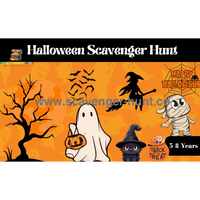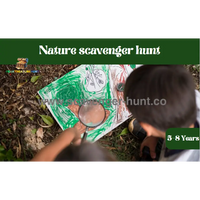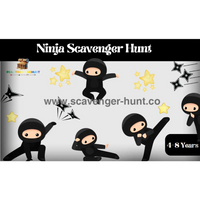🙂Junior Detective Academy: The Ultimate Mystery Treasure Hunt Guide
Introduction
Hello! As a former Kriminalkommissar turned children's party organizer in Berlin, I've spent years creating exciting detective treasure hunts that challenge young minds. There's nothing quite like watching children transform into mini-detectives, using their wit and observation skills to crack codes and solve mysteries. Whether you're planning a Kindergeburtstag or a weekend activity, this guide will help you create an engaging detective hunt that develops critical thinking skills in children aged 4-12. From my experience working with German families, I can tell you that kids love nothing more than feeling like real investigators!
Setting Up Your Detective Case
Every thrilling detective treasure hunt needs proper preparation:
- Case files (age-appropriate mysteries)
- Detective badges (easily made from cardboard)
- Magnifying glasses (one per child)
- Evidence markers (numbered cards)
Pro-Tip: Create a "Detektivbüro" (detective office) as headquarters using a corner of your room!
You’ve finally decided to take on the role of a detective. Whether you’re solving a small neighborhood mystery or chasing down an elusive criminal, there’s one thing you need to do first—set up your case properly. It’s not as glamorous as the chase, but it’s essential for success. Here’s how to get started.
1. Define the Problem Clearly 🧐
Before you jump in, you need to understand exactly what you're dealing with. Is it a missing person? A suspicious robbery? Or perhaps something stranger, like a case of corporate espionage? Whatever it is, write it down. The clearer the problem is in your head, the easier it will be to spot inconsistencies or leads later.
-
Pro Tip: Don’t get caught up in too many details right away. Start simple. The finer points will unravel as you dig deeper into the case.
2. Gather Initial Information 🔍
Every case starts with a handful of facts—some will be useful, and others just noise. Make sure you gather everything you can, even if it feels irrelevant at the moment. You never know which small detail might crack the case wide open. Begin by interviewing anyone connected to the case or revisiting the scene of the crime if possible.
-
People to interview:
- Witnesses
- Victims (if any)
- Friends or family
- Suspects (but tread carefully here)
Also, collect physical evidence if it's available: photos, documents, and anything that might give you insight.
"Sometimes it's the smallest pieces of evidence that carry the most weight." – Every detective ever
3. Organize Your Clues 🗂️
Once you’ve collected your initial data, it’s time to organize it. This step is crucial because it helps you see the big picture. A cluttered mind leads to a cluttered case, and trust me, you don’t want that.
Create a case board. This could be as old-school as a corkboard with pins and strings (yes, like in the movies!) or a modern digital version using apps or software. Whatever works for you, make sure to group your clues logically.
-
Photos of the crime scene, suspects, or any other visual evidence.
-
Statements from witnesses or anyone involved.
-
Motive possibilities – Who stands to gain the most? Why?
Make connections where you can. Maybe Witness A was in the same place as Suspect B, or the time of the crime contradicts someone's alibi. Seeing everything laid out helps to make sense of the chaos.
4. Establish a Timeline ⏳
Every detective knows the importance of a timeline. Start building a sequence of events. This helps create context around the mystery and can often show you where things don’t add up. Ask yourself:
- What happened first?
- When did the victim or suspect last make contact with anyone?
- What gaps are there in the story?
A strong timeline can expose inconsistencies in alibis or suggest where a suspect might have slipped up. This step also gives your case structure, so you’re not just chasing random threads.
5. Look for Patterns 🔄
Patterns can often solve cases. Look for recurring elements in the case—whether in behavior, location, or timing. Does the crime seem opportunistic or planned? If it’s a serial case, do the crimes occur in a particular location or follow a predictable pattern?
Patterns can also help you identify the type of person you're dealing with. A crime of passion, for example, will look very different from a calculated scheme.
"Criminals are creatures of habit. Find the habit, and you find the criminal."
6. Follow Your Gut, But Back It Up 💡
This might sound odd, but trust your instincts. As a detective, you’ll sometimes have a “hunch” about where the case is heading. However, don’t let gut feelings lead you to conclusions without evidence to back them up. Always follow through with solid proof.
A gut instinct can push you in the right direction, but without real evidence, it won’t hold up in court. So, while intuition is important, your case file should always have a factual backbone.
7. Keep a Journal or Case File 📝
You need a record of everything. And I mean everything. Write down every lead, conversation, and piece of evidence that comes your way. Even your thoughts on the case should be logged. Sometimes, a random idea you had on day one will suddenly make sense weeks later.
A good detective is always prepared for a sudden breakthrough. Keep your notes clear and organized, so you can refer back to them when necessary.
8. Stay Objective 🧠
As the case unfolds, it’s easy to get emotionally involved, especially if there’s a personal connection. But as a detective, you need to stay objective. Don’t let your feelings cloud your judgment.
If you’re too focused on proving one person’s guilt, you might overlook key evidence that points in another direction. Keep an open mind, and let the facts guide you.
9. Communicate Regularly with Your Team 🗣️
If you’re working with others, communication is key. Whether you have a partner, informants, or a whole team, make sure everyone is on the same page. Share updates regularly, and don’t hesitate to ask for help if you hit a wall.
Sometimes a fresh set of eyes can spot something you missed.
Final Thoughts: The Set-Up is Everything 🎯
A solid foundation is the bedrock of any successful investigation. The steps you take at the start will often determine how the case unfolds. Sure, you’ll hit dead ends, and sometimes the path will twist in ways you never expected. But with a methodical approach, you’re giving yourself the best shot at uncovering the truth.
And remember, every detective, no matter how experienced, starts each case the same way: with a mystery, a few clues, and a whole lot of questions. Good luck out there—you're going to need it! 👀
Creating Mystery Clues and Evidence
Design your detective hunt with these elements:
- Invisible ink messages (lemon juice works great!)
- Fingerprint analysis (using simple ink pads)
- Secret codes (simple substitution ciphers)
- Mystery photographs
According to educational studies, puzzle-solving activities improve logical thinking skills by 67% in children!
So, you’re knee-deep in your detective case, and it’s time to start piecing together the clues. But where do these clues come from? How do you build a trail that leads to the truth—or even better, how do you create just enough mystery to keep the case interesting? 🤔
Crafting clues and evidence can be an art form. Done right, it makes your investigation feel immersive and challenging, but not impossible. Let’s dig into how to make this part of the detective game both compelling and realistic.
1. Start with the Big Picture 🎯
Before you can drop clues, you need to have a clear idea of the larger mystery. Ask yourself:
- What's the overall crime or puzzle?
- Who's involved?
- What’s the motive?
- Is there a hidden agenda or a twist waiting to be uncovered?
Once you know the full scope of your case, it’s easier to plant clues that lead toward solving it. Think of it like laying breadcrumbs, but knowing exactly where the trail is supposed to go. Don’t worry if the whole picture isn’t clear right away; sometimes the case will reveal itself as you go.
2. Types of Clues to Consider 🔦
Not all clues are created equal. Some will be obvious, some subtle, and others will be red herrings (those false leads meant to throw you off the scent). Variety is the spice of any great mystery. Here are a few types of clues to think about:
-
Physical Evidence: Objects found at the scene. Think fingerprints, a murder weapon, a torn piece of clothing, or something innocuous like a cigarette butt.
-
Documents and Records: Written evidence is often a gold mine for detectives. This can include text messages, emails, receipts, or official documents like wills or contracts.
-
Eyewitness Accounts: People who saw (or think they saw) something can provide important clues. Just remember, eyewitnesses aren't always reliable, and they may have their own biases or agendas.
-
Behavioral Patterns: A suspect's behavior can be a clue in itself. Someone acting out of character, avoiding certain places or people, or lying about their whereabouts can tell you a lot without them saying much at all.
-
Environmental Clues: The setting itself can offer important hints—like weather conditions, time of day, or even a strange object out of place (a wet footprint inside a dry house, for example).
Mixing these types of clues helps build a layered mystery that feels organic and complex.
3. Clue Placement: Less Is More 🗺️
While it might be tempting to scatter clues everywhere, don’t overwhelm yourself—or the investigation. Good mysteries often hold back, releasing clues slowly over time. This keeps things from getting too easy and gives the case room to breathe.
For example, rather than finding all the evidence at the crime scene in one swoop, maybe a key piece of information is only discovered days later in an overlooked room. This delay adds tension and makes the case feel dynamic. ✨
Also, leave room for some surprises! Maybe the next clue doesn’t appear until a suspect is questioned again or until another event forces a new perspective on existing evidence.
4. Red Herrings: The Art of Deception 🐟
Red herrings are your chance to mislead and keep everyone on their toes. They’re fake clues or misinterpretations that, while logical, lead to a dead end.
However, be careful not to overuse them. If every clue turns out to be a false lead, it can become frustrating instead of challenging. A well-placed red herring can keep the tension high, but always balance it with real clues that inch you closer to solving the case.
For example:
-
The obvious suspect: Maybe everyone is sure it’s the jealous ex-lover, but as the case unfolds, the real culprit could be someone unexpected.
-
Contradictory evidence: You might find conflicting reports or pieces of evidence. One says the suspect was at work, but a witness claims they saw them elsewhere. Which lead do you follow?
The key to a great red herring is that it makes sense at first glance but, when looked at more deeply, falls apart. It adds complexity to the investigation without derailing the whole case.
5. Building Suspense with Missing Information 🕰️
Sometimes, what you don’t find can be just as important as what you do. Missing information can leave gaps in the story, forcing you (or the characters) to think harder and search deeper.
For example:
- A missing page from a diary 📝 could mean someone tore it out to hide something.
- A lack of fingerprints where there should be some can imply someone carefully wiped down the scene.
Leaving out certain pieces of evidence builds suspense because the detective (and the reader) knows something is wrong but can’t quite figure out what.
This also gives you room to introduce new clues later in the story without making it feel like they came out of nowhere.
6. Let the Characters Help 👥
Your suspects, witnesses, and even your detective themselves can become clues in their own right. People tend to reveal things in ways they don’t even realize—through body language, offhand comments, or inconsistencies in their stories.
- A suspect who keeps nervously glancing at a particular object might be hiding something.
- A witness who is overly eager to help could be lying or covering something up.
Always keep your characters active in the case. Even if they’re not offering direct clues, their behavior, conversations, and interactions should drive the investigation forward.
7. Tie It All Together 🎬
As the case progresses, the clues should start to connect. Random pieces of evidence that seemed irrelevant at first should begin to make sense when put together. Ideally, this is where the detective (and the reader or player) has an “aha!” moment where everything clicks.
But be careful: don’t force the connection too soon. Let the case naturally evolve. Some clues might not fit right away, and that’s okay. Part of the fun of a mystery is the journey of discovery. 🧩
Final Thoughts: Crafting the Perfect Trail of Evidence 🗝️
Creating clues for a detective case is like building a puzzle, but one where you don’t show all the pieces at once. It’s a balancing act—giving just enough to keep the investigation moving, while holding back enough to keep the suspense alive.
As you place each clue or piece of evidence, think about how it pushes the story forward. Does it raise more questions than it answers? Does it reveal something new about the suspects or the crime?
In the end, it’s all about the thrill of the chase. Your clues should keep everyone guessing, thinking, and—most importantly—searching for the truth. Happy sleuthing! 🔍🕵️♂️
Detective Tools and Equipment
Essential items for your young investigators:
- Notepads (Detektivhefte)
- UV flashlights for secret messages
- Fingerprint dusting kits (cocoa powder works safely!)
- Evidence collection bags
Remember: Safety first - all tools should be kind-safe and TÜV-approved!
Every great detective has a toolkit, not just full of gadgets, but also the right skills and knowledge to crack even the toughest cases. Whether you’re investigating a shady murder or trying to figure out who swiped the last piece of cake from the fridge (a serious crime in its own right 🍰), the tools you use can make all the difference.
In this chapter, we’ll break down the essential tools every detective should have at their disposal—both the physical gadgets and the mental gear you need to succeed.
1. Notebook and Pen 📝✒️
Let’s start with the basics. As old-school as it sounds, a notebook and pen are must-haves for any detective. Sure, we live in a world with smartphones and digital apps, but there’s something reliable about jotting things down by hand. Plus, it helps you think as you write.
-
Why it matters: You’ll be interviewing people, noting down observations, and recording clues. Having a notebook on hand ensures you capture every important detail.
-
Tip: Keep your notes organized! Label everything with dates and times so you can easily reference back later when the details start to blur together.
2. Smartphone 📱
Okay, while the notebook is a classic, you can’t deny the power of technology. A good smartphone is practically a detective’s pocket assistant. From snapping photos of evidence to recording interviews, it’s an all-in-one device.
-
Camera: You’ll want to document crime scenes, evidence, or even people of interest. Always make sure to take clear, focused pictures (no blurry shots, please).
-
Voice recorder: Need to record a conversation or an interview? Your phone’s voice memo app will come in handy. Pro tip: ask for permission before recording unless you're in a legal setting where it’s allowed.
-
GPS and Maps: Tracking locations, navigating to crime scenes, or mapping out potential escape routes—it’s all there.
Bonus: Some smartphones have apps for everything, including note-taking, document scanning, and even crime scene mapping. Stay up-to-date with tech!
3. Camera (Forensics-Grade) 📸
If your case involves serious crime scene work, you’ll need more than your smartphone. A high-quality forensic camera lets you capture detailed images that could hold up in court. This camera will help you zoom in on fine details, such as footprints, fingerprints, or even the slight indentations of a note left behind.
-
Important features: High resolution, good lighting options, and macro lenses for close-up shots. A good flash is essential for night-time work or dimly lit rooms.
-
Why it matters: Photos are hard evidence. They don't lie, and they preserve the scene exactly as it was, which can be crucial if something changes later.
4. Magnifying Glass 🔍
Yes, this is a classic detective tool, and you might think it’s just a cliché, but a magnifying glass still has its uses! It’s perfect for examining tiny details that the naked eye can miss. Whether it’s a small clue like a hair strand, a fragment of paper, or subtle damage to a lock, a magnifying glass will help you see the details up close.
-
Why it matters: Sometimes the smallest evidence can solve the biggest mysteries. A single fiber or fingerprint can unravel the whole case.
-
Tip: Choose a magnifying glass with an integrated light for when you’re working in darker areas.
5. Fingerprint Kit 🖐️
Fingerprints are one of the oldest forms of forensic evidence, and they’re still incredibly reliable. A portable fingerprint kit is essential for gathering prints from crime scenes.
Pro Tip: Not every surface will hold fingerprints. Be selective about where you dust—non-porous, smooth surfaces (like glass or metal) work best.
6. Flashlight 🔦
A detective’s trusty flashlight is more than just a tool for when the power’s out. You’ll need a high-quality one for checking dark areas, basements, alleyways, and crime scenes at night. You’d be surprised how many clues are hiding in the shadows—whether it’s a small bloodstain, a hidden door, or a discarded piece of evidence.
-
Why it matters: In low-light conditions, it’s your eyes. A powerful beam can help you scan large areas quickly or focus on something specific.
-
Tip: Invest in a flashlight with adjustable brightness levels and a long battery life. You don’t want it to die on you mid-investigation! 🌑
7. Evidence Bags 🛍️
When you come across physical evidence, you can’t just toss it in your bag and move on. Evidence needs to be carefully collected and preserved. That’s where evidence bags come in. They prevent contamination and help you maintain a proper chain of custody, so you know exactly where each piece of evidence has been and who handled it.
-
Types: There are different types of evidence bags for different items—plastic bags for small objects, paper bags for items that might contain moisture (like clothes), and boxes for delicate evidence.
-
Why it matters: Keeping evidence uncontaminated is crucial, especially if it’s going to court. Anything improperly handled can be thrown out, and that’s the last thing you want.
8. Surveillance Gear 🎥
Sometimes, you need to watch without being seen. A good set of surveillance tools can be key in gathering information covertly. This can range from a simple pair of binoculars to more advanced hidden cameras and microphones.
-
Binoculars: Essential for observing people from a distance. If you’re staking out a location, binoculars help you stay discreet while gathering visual information.
-
Hidden Cameras: For more intense operations, you might need to set up hidden cameras in strategic locations to track suspects without being detected.
-
Why it matters: Surveillance allows you to gather evidence over time, especially if you suspect someone’s involved in illegal activities but don’t have direct proof yet.
9. Disguise Kit 🕶️🎩
Not every case will require you to go full undercover, but having some basic tools to change your appearance can be handy in a pinch. A well-timed disguise could be the difference between getting noticed by a suspect and blending into the crowd.
-
What’s in the kit?
- Hats, glasses, wigs, or fake beards.
- Changes of clothing to suit different environments.
-
Why it matters: Sometimes, you’ll need to observe a suspect without them knowing they’re being watched. A simple change in appearance can throw people off and help you stay under the radar.
10. The Most Important Tool: Your Mind 🧠💡
While all the gadgets and gear are great, the most powerful tool a detective has is their own brain. Observation, critical thinking, and problem-solving are at the core of every investigation. You’ll need to be constantly piecing together clues, questioning motives, and thinking outside the box.
-
Why it matters: Tools only help you get the evidence. It’s your mind that makes sense of it all. Detectives who rely too much on technology can miss the bigger picture or overlook obvious conclusions.
Final Thoughts: Gearing Up for Success 🧳
Being a detective is about more than the tools in your bag. While equipment like fingerprint kits, cameras, and flashlights are essential, it’s how you use them—and how you combine them with your sharp instincts and detective skills—that truly cracks a case.
A well-equipped detective is always prepared for the unexpected. Whether you’re following a lead into a dark alley or uncovering a long-lost piece of evidence, your tools should always be an extension of your investigative instincts. Stay sharp, stay organized, and most importantly, always trust your gut. It’s the one tool that never fails. ✨🔍
Investigation Techniques
Teach these basic detective skills:
- Observation exercises ("Spot the Difference")
- Logic puzzles appropriate for each age
- Pattern recognition games
- Simple forensic science activities
Research shows that detective-style activities can improve memory retention by 75%!
A good detective knows that solving a case isn’t just about finding clues—it’s about knowing how to find them and, even more importantly, what to do with them. Investigation techniques are the backbone of every case, helping you get from point A to B when the path isn’t always clear.
In this chapter, we’re diving into the various methods and strategies you can use to gather information, analyze it, and piece together the truth. Let’s get those wheels turning! 🧠🔍
1. Observation: Eyes Wide Open 👀
The most fundamental technique in any investigation is observation. The ability to notice details—especially the ones others miss—can often mean the difference between solving a case and hitting a dead end.
When you arrive at a crime scene or are investigating a suspect, don’t rush. Slow down, take in everything around you. What stands out? What’s out of place? Is there something missing that should be there?
-
Look for the ordinary and the extraordinary: Sometimes it’s the subtle things—a moved chair, an open window—that tell the story.
-
Body language: When you’re talking to suspects or witnesses, watch how they act. Do they fidget when they answer a specific question? Do they avoid eye contact? Their bodies can sometimes give away more than their words.
Tip: Don’t just focus on the big picture. Little details, like an unusual smell, a strange sound, or even the way a person is dressed, can be clues waiting to be uncovered. 📸
2. Interviewing: Get Them Talking 🗣️
Interviewing is both an art and a science. You’ll need to know how to ask the right questions, but also when to listen carefully—and more importantly, how to listen. The key to a good interview isn’t just gathering facts; it’s understanding the truth behind what people are saying.
-
Open-ended questions: Instead of asking yes/no questions, let the interviewee tell their side of the story. “What happened that night?” is way more helpful than, “Did you see the suspect?”
-
Build rapport: People are more likely to open up if they feel comfortable. Establish a connection, show empathy, and don’t make them feel like they’re under attack.
-
Watch for inconsistencies: People lie, sometimes by omission, sometimes straight to your face. Pay attention to contradictions in their stories. If someone changes their version of events or dodges certain details, that’s a red flag. 🚩
Pro Tip: Silence can be your best friend. After someone answers a question, pause for a few seconds. People tend to fill awkward silences by talking more, and that’s when they often reveal more than they intended. 😏
3. Forensic Techniques: Science Meets Sleuthing 🔬
Forensic investigation is where science and detective work collide. It's one thing to observe a crime scene, but it’s another to apply forensic techniques that can uncover the truth hidden in the smallest details.
-
Fingerprint Analysis: Classic, but still incredibly effective. Fingerprints can place someone at the scene, on the weapon, or near the victim.
-
DNA Evidence: One of the strongest pieces of evidence in modern investigations. DNA can link suspects to a crime with remarkable precision. Whether it’s hair, blood, or skin cells left behind, a good DNA sample can make or break a case.
-
Ballistics: If a firearm is involved, ballistics analysis can tell you where the shot came from, the type of weapon used, and sometimes even trace it back to the shooter.
Tech Tip: Technology has revolutionized forensic techniques. Facial recognition, digital forensics (like analyzing hard drives), and even 3D crime scene reconstruction are now common tools that give detectives an edge. Use them wisely!
4. The Power of Surveillance 🎥
Surveillance is all about keeping a close eye on suspects without them knowing. It’s one of the most effective ways to gather information without direct confrontation. There are several techniques you can use here, ranging from simple observation to more complex setups.
-
Stakeouts: Sometimes, the old-fashioned stakeout is the best way to track a suspect’s movements. Grab some coffee, park your car in a discreet location, and keep those eyes peeled.
-
Hidden Cameras: If you need to monitor someone’s home, business, or meeting spot, hidden cameras can provide hours of footage without raising suspicion.
-
Digital Surveillance: Don’t forget about online monitoring. Social media, email, or even phone records can be a goldmine of information. People tend to leave digital footprints they’re not even aware of.
Patience is key here. Surveillance is often more about waiting than acting. You might sit through hours (or days) of nothing before finally catching a crucial moment. 🕰️
5. Interrogation: Getting to the Truth 🔦
Interrogation isn’t the same as a casual interview. This is the next level, often involving suspects you believe are directly involved in the crime. It’s about getting them to reveal what they know—or confess outright.
-
Good cop, bad cop: It’s a cliché for a reason—it works. One detective plays sympathetic, the other aggressive. This emotional push-and-pull can wear down a suspect’s defenses.
-
Psychological pressure: The goal is to make the suspect feel uncomfortable enough to confess without crossing legal or ethical lines. Use pauses, silence, or direct eye contact to create a sense of tension.
-
Lies and contradictions: Corner the suspect by pointing out inconsistencies in their story. If they keep changing their version of events, calmly present the evidence against them.
Warning: Interrogations can be intense, and mistakes here can lead to false confessions. Always ensure you’re following proper legal protocols, and never force someone to confess under duress.
6. Background Checks: Digging into the Past 📂
Sometimes, what you don’t see in the present can be uncovered in someone’s past. Background checks are a key investigative technique for uncovering hidden motives, past crimes, or connections between individuals that aren’t immediately obvious.
-
Criminal records: Does the suspect have a history of similar crimes? Are there any restraining orders, violent tendencies, or suspicious financial activity?
-
Financial records: Money often leaves a trail. Bank statements, credit card transactions, or large, unexplained withdrawals can be telling signs.
-
Online presence: Social media posts, forum interactions, or even old emails can reveal a lot about someone’s character and past behavior. People tend to share more online than they should. 😉
Pro Tip: Always cross-reference background checks with your current findings. A suspect’s past can help explain their present actions or uncover hidden connections.
7. Reconstructing the Crime Scene 🗺️
Sometimes the best way to solve a case is to recreate it. Crime scene reconstruction involves piecing together the events leading up to, during, and after the crime to form a clearer picture of what really happened.
-
Timeline analysis: Recreate the sequence of events. When did the suspect arrive? What time was the crime committed? Who was where? A solid timeline can expose gaps in alibis and suspicious behavior.
-
Motive and opportunity: Reconstructing the scene can often highlight the why behind a crime. It might also show who had the opportunity to commit it—who was closest to the victim, who had access to the weapon, etc.
-
Re-enactments: Sometimes you’ll want to physically re-enact the crime to test theories or alibis. Can someone actually walk from point A to point B in the time they claimed? Was there enough light for a witness to see what they said they saw? These are questions you can answer by recreating the scene.
8. Follow the Money 💵
They say “money talks,” and in many cases, following the money trail is what leads to the truth. Whether it’s fraud, theft, or even murder, financial motives are often at the heart of a crime.
-
Bank statements and transactions: Look for large, unexplained withdrawals, sudden transfers, or hidden accounts.
-
Property ownership: Sometimes the key isn’t cash, but assets. Homes, cars, and businesses can be tied to criminal activity, money laundering, or simply point toward a hidden motive.
-
Bribes and debts: Financial pressures can push people to do things they normally wouldn’t. Check if the suspect is in debt, owes money to dangerous people, or is receiving unexplained income.
Pro Tip: Financial crimes are often linked to larger conspiracies, so don’t just stop at the surface. Dig deep—you might be surprised at what you find beneath all those zeros. 🧐
Final Thoughts: The Detective’s Approach 🎯
Investigation techniques are all about balance. You need to combine observation with science, patience with action, and empathy with pressure. It’s about following the right threads without pulling too hard on any one of them.
Remember, solving a case is rarely a straight line. It’s a web of clues, suspects, and motives that you’ll have to untangle. With the right techniques in your toolbox, though, you’ll find your way to the truth—one clue at a time.
Now, it’s time to put these methods into action. Happy investigating, detective! 🔍👊
Making Learning Fun
Incorporate educational elements into your detective hunt:
- Math problems disguised as code-breaking
- Reading comprehension through case files
- Scientific observation skills
- Deductive reasoning exercises
Learning doesn't have to be a chore! In fact, when done right, it can be an adventure that’s exciting, engaging, and even a little addictive (in the best way possible 😄). Whether you’re a student trying to get through your schoolwork or a teacher wanting to inspire your class, the secret to success is making learning fun.
In this chapter, we’ll explore some creative and effective ways to transform boring lessons into activities that everyone will love. So, grab your notebooks (or tablets), and let’s dive in!
1. Gamify the Process 🎮🏆
One of the best ways to make learning more enjoyable is by turning it into a game. Gamification taps into our natural desire for competition, rewards, and a sense of achievement. The trick is to take something educational and layer on some fun elements, like points, levels, and challenges.
-
Points and Rewards: Assign points for completing tasks, quizzes, or even for good participation. Set up a reward system—like earning a small prize or bonus activity after hitting a certain number of points.
-
Leaderboards: Create a friendly competition by setting up a leaderboard. It doesn’t have to be about grades—it can be for effort, creativity, or teamwork. Seeing progress compared to others can push people to go that extra mile.
-
Quizzes as Games: Turn study sessions into trivia nights or quiz battles. Apps like Kahoot! or Quizlet are great for turning learning into a competitive game that’s fast-paced and fun.
Tip: The goal is to make everyone feel engaged, not stressed. Keep it light and fun—no one likes a high-pressure environment! 🌟
2. Incorporate Hands-On Activities 🎨✂️
Let’s be honest: staring at a textbook for hours isn’t exactly thrilling. But when you bring in hands-on activities, learning becomes an immersive experience where students get to create, experiment, and see concepts in action.
-
Science Experiments: There’s a reason kids love science labs! Watching chemical reactions, building volcanoes, or even creating slime teaches them scientific principles in a way that’s memorable (and fun!). Plus, it gives a visual and tactile component to abstract concepts.
-
Art Projects: Bring subjects to life through art. Whether it’s drawing historical events, creating models of DNA, or designing a cover for a book report, allowing students to express what they’ve learned creatively helps reinforce the material.
-
Role-Playing: History, literature, and even science can be taught through role-playing. Imagine a classroom where students debate as if they’re historical figures or act out scenes from a novel. It’s a great way to build empathy and deeper understanding of the subject.
Bonus: Hands-on learning isn’t just for kids. Adults can benefit too—try building a model, crafting a visual aid, or even acting out case studies in a business setting. It makes abstract ideas feel tangible.
3. Storytelling: Turn Lessons into Adventures 📖✨
Everyone loves a good story. Whether it’s a mystery, a heroic adventure, or a funny anecdote, stories have a way of sticking with us. So, why not turn your lessons into stories?
-
Narrative Learning: When teaching new concepts, try framing them as part of a bigger story. For example, teaching history? Tell it like an epic saga filled with characters, conflicts, and drama. People remember stories far better than dry facts.
-
Mystery Solving: Set up a "mystery" that students have to solve using what they’ve learned. This can work for anything from math problems to history quizzes. Turning a challenge into a puzzle taps into curiosity and makes students feel like detectives on the case. 🔍🕵️♀️
-
Personal Anecdotes: Share your own stories related to the topic. It doesn’t have to be directly about the lesson, but relating it to real life makes it feel more relatable and human.
Tip: The more immersive the story, the better. Use voices, humor, or suspense to draw your audience in. They’ll be hooked before they know it!
4. Incorporate Technology and Interactive Tools 💻📱
There’s no denying it—technology is a huge part of our world, and when used right, it can make learning far more interactive and exciting.
-
Learning Apps: Apps like Duolingo (for languages), Khan Academy (for a wide range of subjects), and Prodigy (for math) turn learning into an interactive game. These apps often incorporate rewards, streaks, and progress bars to keep users motivated.
-
Virtual Reality (VR): VR can transport students to different times, places, or even inside a human body. Imagine learning about ancient Egypt while walking through the pyramids or studying marine biology while "diving" in a virtual ocean. Talk about making lessons unforgettable! 🏛️🌊
-
Interactive Whiteboards: Tools like Smartboards or Promethean boards allow teachers and students to interact with lessons by drawing, solving problems, or even playing educational games together.
Pro Tip: Balance is key. While tech can enhance learning, too much screen time can lead to burnout. Mix in other forms of learning to keep things fresh.
5. Learning Through Movement: Get Up and Go! 🏃♀️🧠
Sitting at a desk all day is exhausting. Incorporating movement into learning not only makes it more enjoyable, but it can also boost memory and focus.
-
Active Games: Play learning games that require movement—like vocabulary relay races or math scavenger hunts. You can set up stations around the room or outdoors where students complete tasks related to the lesson.
-
Learning with Music and Dance: Have students come up with a dance or song that helps them remember key concepts. Whether it’s dancing through the water cycle or rapping the periodic table, adding rhythm and movement makes ideas stick. 🎶💃
-
Physical Breaks: Even short, 5-minute movement breaks can refresh everyone’s brains and make the next lesson more effective. Try stretching, quick dance-offs, or walking while reviewing notes.
Why it works: Movement increases blood flow, wakes up the brain, and keeps energy levels up. Plus, it’s just fun to shake things up (literally)! 🤸♂️
6. Incorporate Playful Challenges and Puzzles 🧩🧠
Humans love puzzles, and the brain thrives on challenges. If you can turn your lesson into a puzzle to solve, students will dive in with enthusiasm.
-
Escape Room Challenges: Create a classroom “escape room” where students have to solve problems or answer questions to “unlock” the next clue. This could be digital or physical, and it works for any subject!
-
Crosswords and Word Searches: These classic games can be adapted to any subject. For example, make a crossword with vocabulary words or a word search with scientific terms.
-
Logic Puzzles: Math and logic puzzles not only sharpen problem-solving skills but also make math feel like a fun challenge instead of a scary subject.
Tip: Make sure the puzzles are appropriately challenging—not too hard, not too easy. The sweet spot is where students feel stretched but not frustrated.
7. Collaborative Learning: Team Up! 🤝👥
Learning doesn’t have to be a solo experience. In fact, working with others can make it far more enjoyable. Collaboration encourages discussion, creativity, and different perspectives.
-
Group Projects: Whether it’s a science experiment or a research presentation, group projects give students the chance to work together, share ideas, and learn from one another.
-
Peer Teaching: Have students take turns teaching sections of the lesson to each other. It reinforces what they’ve learned and helps them develop communication skills. Plus, students sometimes explain things in ways that are easier for their peers to understand.
-
Debates and Discussions: Break the class into teams and have them debate or discuss a topic. It could be related to history, ethics, science, or even current events. Not only does this build critical thinking skills, but it also makes learning social and dynamic.
Pro Tip: Set clear guidelines to ensure collaboration stays productive and that everyone contributes equally. Teamwork should be fun, not frustrating! 💬
8. Celebrate Small Wins and Progress 🎉👏
Learning is a journey, and it’s important to celebrate every step along the way. Recognizing progress—no matter how small—helps maintain motivation and builds confidence.
-
Milestone Celebrations: When students hit certain goals, celebrate it! This could be completing a chapter, mastering a tough concept, or improving on a test. It could be something as simple as clapping, giving out stickers, or letting them pick the next activity.
-
Personal Progress Tracking: Have students keep track of their own growth. They could keep a journal, use a chart, or log their progress in an app. Seeing their own improvement over time is often a motivator in itself.
-
End-of-Unit Parties: At the end of a big project or unit, throw a small party or celebration. Not only does it mark the achievement, but it also gives students something to look forward to. 🎈🎊
Tip: Don’t focus only on big achievements. Celebrate effort, creativity, and persistence too. It keeps the learning atmosphere positive and encouraging.
Final Thoughts: Making Learning an Adventure 🗺️🎈
At its heart, making learning fun is about engagement. It’s about transforming lessons from something you have to do into something you want to do. By adding creativity, movement, games, and collaboration, you can turn any subject into an exciting adventure.
So whether you’re the student or the teacher, remember: learning doesn’t have to be boring. With a little effort and imagination, every lesson can be a chance to explore, grow, and most importantly—have fun!
Ready to turn the next lesson into an adventure? Let’s go! 🚀🎒
Frequently Asked Questions
Q: How do I adjust the difficulty for different age groups?
A: For ages 4-6, focus on visual clues and simple matching. Ages 7-9 can handle basic codes and puzzles, while 10-12 can tackle more complex mysteries.
Q: What's the ideal duration for a detective treasure hunt?
A: Plan for 45-60 minutes for younger kids, up to 90 minutes for older ones. Include breaks for "detective meetings"!
Q: How can I involve multiple children of different ages?
A: Assign different roles: older kids can be "Senior Detectives" helping younger "Junior Investigators" solve cases together.
Q: What if some children get frustrated with difficult clues?
A: Have backup hints ready and remember our German saying "Der Weg ist das Ziel" - it's about the journey, not just solving the mystery.
Q: How much should I budget for detective supplies?
A: With clever shopping at German stores like Müller and DM, you can create a great kit for €30-40.
Conclusion
Creating an engaging detective treasure hunt is about balancing challenge with achievement. From my years of experience organizing these hunts in German homes and schools, I've learned that the best mysteries are those that make every child feel like a successful detective. Start simple, build confidence, and watch as ordinary spaces transform into scenes of fascinating investigation. Remember, we're not just creating games - we're developing young minds and future problem-solvers!
Discover our Complete Scavenger Hunts Collection.









































